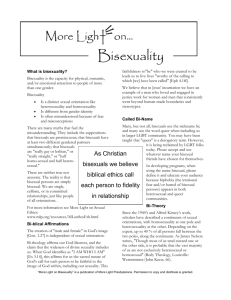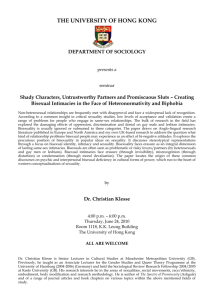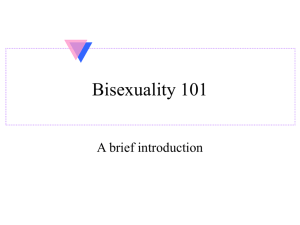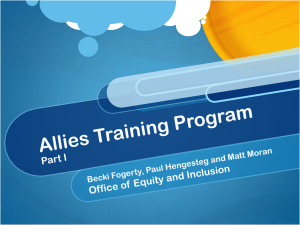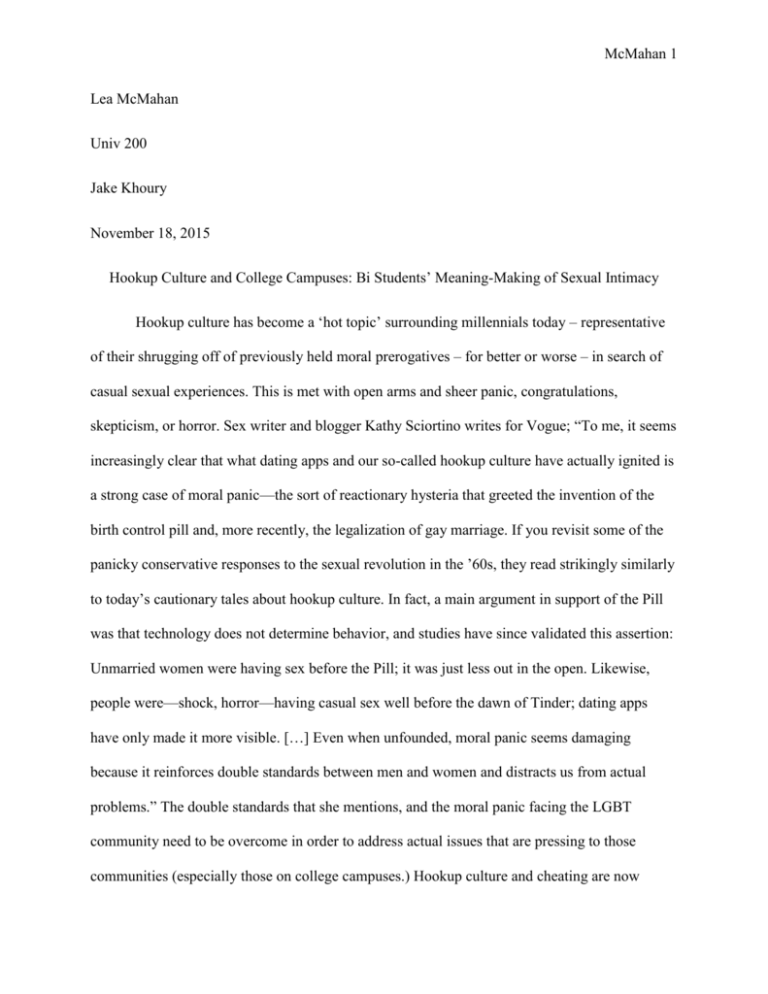
McMahan 1
Lea McMahan
Univ 200
Jake Khoury
November 18, 2015
Hookup Culture and College Campuses: Bi Students’ Meaning-Making of Sexual Intimacy
Hookup culture has become a ‘hot topic’ surrounding millennials today – representative
of their shrugging off of previously held moral prerogatives – for better or worse – in search of
casual sexual experiences. This is met with open arms and sheer panic, congratulations,
skepticism, or horror. Sex writer and blogger Kathy Sciortino writes for Vogue; “To me, it seems
increasingly clear that what dating apps and our so-called hookup culture have actually ignited is
a strong case of moral panic—the sort of reactionary hysteria that greeted the invention of the
birth control pill and, more recently, the legalization of gay marriage. If you revisit some of the
panicky conservative responses to the sexual revolution in the ’60s, they read strikingly similarly
to today’s cautionary tales about hookup culture. In fact, a main argument in support of the Pill
was that technology does not determine behavior, and studies have since validated this assertion:
Unmarried women were having sex before the Pill; it was just less out in the open. Likewise,
people were—shock, horror—having casual sex well before the dawn of Tinder; dating apps
have only made it more visible. […] Even when unfounded, moral panic seems damaging
because it reinforces double standards between men and women and distracts us from actual
problems.” The double standards that she mentions, and the moral panic facing the LGBT
community need to be overcome in order to address actual issues that are pressing to those
communities (especially those on college campuses.) Hookup culture and cheating are now
McMahan 2
normalized, especially on American college campuses; this creates an environment that allows
students to explore their sexuality, while at the same time negatively influencing them with
internalized homophobia and biphobia, potentially creating a need to adhere to heteronormative
ideals.
Scholarly understanding of hookup culture as it stands now is fairly heteronormative;
however, this narrow view is flawed, as hookups are not only frequent, but the most common
way of students meeting with others, experiencing sexual intimacy, and exploring their sexuality.
A social interaction with such significance and variance should not only be examined more
thoroughly, but through lenses other than the usual heteronormative assumptions. In her peerreviewed article, “Monogamy Lite: Cheating, College, and Women,” Amy Wilikins explains;
“interviews with students reveal that students can mean anything from a kiss to sexual
intercourse to sexual assault. One study showed that 78 percent has hooked up at least ten times
or more. Only 38 percent of those who had hooked up, however, said that sexual intercourse was
part of their hookup.” (Wilikins 105) As “hooking up” so broadly describes the way that college
students interact, while also being fairly ubiquitous, it can be concluded that it plays a large role
in the lives of students, and heavily impacts their lives. As Alicia Walker found in her peerreviewed study, “‘I’m not a lesbian; I’m just a freak’”: A Pilot Study of the Experiences of
Women in Assumed-Monogamous Other-Sex Unions Seeking Secret Same-Sex Encounters
Online, their Negotiation of Sexual Desire, and Meaning-Making of Sexual Identity, " hookup
culture acts as a means of expression, and provide a means of women expressing their interest in
other women while maintaining a "straight" identity. These women's interest in other women, as
Walker found, is indicative of bisexuality - however the women across the study recoiled at the
idea of a non-straight identity. Walker hypothesized that this was due to internalized
McMahan 3
homophobia. The fact that hookup culture is heteronormative is supported by Walker's study,
"I'm not a lesbian, just a freak," as the women in that study did not view their hookups with other
women as an expression of their sexuality, but rather an expression of a kink. This idea can be
damaging, as it requires people to repress their identity in order to maintain a 'straight' identity.
“[A] dissonance between sexual behavior and sexual identity can result in damaging health
outcomes […]” (Walker 923) The idea of bisexuality as a ‘stepping stone’ or method of
transition between hetero and homosexuality can be damaging, especially to bisexuals, and the
idea of bisexuals as not a legitimate identity, but rather a ‘kink’ or type of sexual deviance can be
harmful, especially in a setting of hookup culture. Because sexual identification is so important
in our culture, one’s chosen label has immense impact on the life the individual leads; their
opportunities and interpersonal interactions are often determined by the chemistry between the
environment and their chosen label. By being in a setting that internalizes biphobia and delegitimizes it as a ‘valid’ identity, bisexuals can be harmed by mislabeling themselves, or finding
a need to misrepresent themselves in order to fit in. “Our sexual identities evolve from the
categories and associated meanings existing within our socio-cultural settings, which influence
and shape their meaning and expression, as well as what is deemed desirable, possible, and
proper. These social constructions surrounding sexual identity labels form and mold the way we
interpret and label our behavior and experience.” (Walker 923) While hookup culture can serve
as a platform for young students to explore their own identities, it can also stir up biphobic
subtext and reinforce the problems that many bisexuals experience with hookup culture.
It is thrilling to live in a time where history is being made within the LGBT community,
especially with the recent legalization of marriage throughout the United States by the Supreme
Court. Despite the recent leap into equality, however, there are still more advances to be made
McMahan 4
both in and out of the LGBT community. In a time with so much visibility and acceptance, there
is an interesting phenomenon occurring where certain identities are being erased, forgotten, or
pushed aside, even within the queer community. Bisexual erasure is a significant problem – even
though several studies suggest that bisexuals make up the largest part of the community, they
still have some of the worst representation. As Lauren Ochs explains, “Some folks say that
bisexuals are not oppressed because at least we are accepted by mainstream society when we are
involved with members of the opposite sex […] But conditional acceptance is not acceptance at
all.” (Ochs) In the media, in civil rights, the visibility of bisexuals is limited at best. They are
either determined to be gay, straight, or defining themselves as bisexual out of greed or
confusion. There is the stereotype of “bi now, gay later” – the idea that bisexuality is merely a
stepping stone to homosexuality. As a result, bi people are not truly accepted in either
community. In one of the Advocate’s articles, the writer talks about the opposition and
oppression he is met with, both in the gay and straight communities, explaining “We’ve fought
so hard to break free and be accepted outside of the heteronormative binary boxes, only to create
our own homonormative binary boxes.” (Cruz) While being gay or lesbian is being increasingly
normalized and accepted, being bi is still in the periphery of the queer community. A scholar of
gender and sexual identity, a woman mislabeled as a lesbian after her marriage to her same-sex
partner explains why bisexuality being an accepted identity is so difficult. “When we assert a
non-dominant identity, we often encounter surprise and disbelief, and our assertions can be
perceived as threatening – an aggressive challenge to the status quo.” (Ochs) It is essential that
bisexuality is recognized as a “dominant” identity within the queer community, as bisexuals are
not a minority at all. According to a study published by the Pew Research Center, bisexuals were
the largest percentage of LGBT people surveyed, coming in at 40%. The next largest group was
McMahan 5
gay men at 36%, and then lesbians at 19%. This information was surprising to me – I always
thought that, as a bisexual, I was a minority within the LGBT community. Despite this large
percentage, less than 28% of the bisexuals in this study stated that they felt comfortable openly
identifying as bisexual. (“A Survey of LGBT Americans”). Biphobia and bisexual invisibility is
a large factor in preventing people feel comfortable with their own sexual identity.
While history is being made in the LGBT community, bisexuals are being pushed to the
side. In the Supreme Court proceedings, the term “bisexual” is never used, whereas the term
“gay” is used 28 times in the first session of the oral arguments alone. Even Mary Bonauto, an
attorney speaking on behalf of all the combined plaintiffs, used the term “gay” as opposed to
“same-sex”: “If a legal commitment, responsibility and protection that is marriage is off limits to
gay people as a class, the stain of unworthiness that follows on individuals and families
contravenes the basic constitutional commitment to equal dignity,” (Bonauto).
The media echoed the rhetoric of the court, using the term “Gay Marriage” as opposed to
“Same-Sex Marriage.” The New York Times titled piece from its editorial board “A Landmark
Gay Marriage Case at the Supreme Court.” Politico, The Huffington Post, Rolling Stone, the
Bloomberg news service, and the Chicago Tribune are just a few of the other major outlets that
also favor “gay marriage” in headlines. While the advances are fantastic, the lack of bisexual
representation threatens to worsen bisexual erasure as a whole. (Reynolds) Historically,
bisexuality has not been acknowledged as large part of the LGBT movement. In the 1970’s,
when the terms “gay” and “lesbian” were emerging in the common vernacular, bisexuality was
still not accepted as an identity, even by members of the community. Bisexuality became more
accepted in the 1990’s, and the term “LGBT” was formed. Despite its taboo reputation,
especially in recent history, it was widely acknowledged and accepted in Ancient Greece and
McMahan 6
Rome. Spartan warriors would seek romantic relationships with their comrades, and would seek
heterosexual relationships outside the military. Although bisexuality has been erased and
overlooked in modern times, its history tracing back thousands of years proves that it is more
than a “phase” or “curiosity,” what it has been reduced to in the eyes of public opinion. It is
essential that bisexuality be accepted as a legitimate identity, both for the LGBT movement to
progress and for the mental health and equality of bisexuals. Many studies show that
representation is essential to feel included and valued within society. The solution to biphobia
and bisexual erasure are simple: visibility and education. By using the terms “bisexual” or
“same-sex” in favor of gay, by having bisexual characters and celebrities, and discussions about
bisexuality, both people in and out of the queer community can learn and understand more about
what it means to be bi. Through better representation and acceptance, hopefully bi people will
finally find a place within queer and straight communities where they feel that they belong. As
Lauren Ochs says, “Inclusion is not about an entitled group of privileged citizens deigning to
open up the big door to let their inferiors in. Inclusion is about acknowledging what already is.
[…] We are pointing out that we are already here, we have been here for a long time, and we ask
that our presence as citizens be recognized legally, culturally, and interpersonally.” (Ochs) As
hookups are a method of expressing one’s sexuality and personal identity, and having these
interactions denied as valid can be damaging to bisexuals, especially during the formative years
of college.
While hookup culture presents the problematic culture of biphobia and bisexual erasure
to young and exploring bisexuals, it also grants them freedom to explore their identity in a safe
space. In her peer-reviewed study, Leila Rupp studied young queer women in order to
understand the way that hookup culture facilitated their own self-discovery. “In these cases, the
McMahan 7
acceptability of kissing other women in the hookup culture facilitated sexual behavior that was
rooted in desire, attraction, and/or love and facilitated an acknowledgement of a nonheterosexual
identity.” (Rupp 223) Rupp explains that hookup culture provides a socially acceptable scene in
which women can express their same-sex desires, especially when it takes the form of public
kissing at parties, as it can be interpreted as solely for the pleasure of straight males. By
seemingly adhering to these ideals, young bisexual women can actually circumvent the social
repercussions of exhibiting a non-dominant identity. Some fear that hookup culture may be
damaging to this generation’s views on relationships. In her article for Slate, “Have emotionally
absent, tech-addled millennials lost the ability to love? No, you’re just old,” Kathy Waldman
responds to one New York Times’ writer’s fears, “when Reiner talks about kids needing to
rediscover “emotional vulnerability,” he is really referring to women. College guys have always
played the field, sloughed off attachment, spread their seed; what’s changed in the past 50 years
or so is that women have begun to treat relationships with the same casualness as their male
peers.” (Waldman) In this quote, Waldman highlights that concern over the implications of
“hookup culture” is a response to the expression of non-dominant identities’ sexualities; those
other than straight, white men asserting their desires and identities is perceived as a threat to the
status quo, and a challenge to “traditional values”.
The duality between the new and old normalization of monogamy and cheating are
indicative of young women's newer definitions of feminine sexuality. "Monogamy is the 'normal'
way to be in a relationship. [...] At the same time, [college women] constitute cheating as
normal." (Wilikins 109) Although I am focusing on college-aged bisexuals, this duality between
it being normal to be monogamous, but also normal to cheat, is a belief widely held by many
college students. In an episode of Star Talk with Neil DeGrasse Tyson, author, journalist, and
McMahan 8
activist Dan Savage argues that cheating and hooking up may be central to our nature. “We’re
not naturally monogamous, it is difficult struggle for us […] [we had] a death penalty for
adultery, while at the same time we run around saying that monogamy comes naturally to us as a
species. No other species has to be threatened with death to do that which comes naturally to
them. […] We should be a little bit compassionate and understanding that monogamy is a
struggle.” This quote points out that our attitude towards cheating as a culture is perhaps more
harsh than science would seem to show humans are naturally inclined to be. Although there is a
large social stigma surrounding cheating, there is simultaneously an avoidance/disinterest in pair
bonding (social monogamy) and sexual monogamy – lack of interest in these areas may cause
“hooking up” and cheating to be increasingly common.
"[w]e find that, for the women in this study, infidelity offers a culturally justifiable way
to exit unwanted relationships while sustaining identities as caring women." (Wilikins 730) Due
to internalized gender constructions, women are typically defined in relationships by their "quest
for love," while men are characterized by their desire for sexual gratification. This study finds
that women use hookup culture and cheating to pave a new path of sexuality, and to navigate the
intersection of age, gender, and class on college campuses. These strategies of maintaining
normative ideals while forming new definitions are likely to be used by not only straight women,
but also bisexual women, and other marginalized groups (such as bisexuals as a whole.) "'It’s so
small,” he said. 'Everybody knows who you are hooking up with or have hooked up with, and
it’s extremely likely that people who you’re interested in have hooked up with or will hook up
with your friends. There’s a mutual understanding that it sucks and that it’s weird, but what else
are you going to do?'" (Lahut, web) In his article, Wesleyan student journalist Jake Lahut notes
that, especially at smaller campuses, hooking up has a tendancy to become 'incestuous' within
McMahan 9
friend groups. This problem, according to Lahut, is increased within the LGBT pool of students
on a college campus, as the group is often smaller than that of heterosexual students. It is
important that these differences in experience be recognized and addressed, by researchers,
counselors, and students alike. "There are people in this world who have the full rights of
citizenship, in our communities, our countries, around the world, and then there are those of us
who, to varying degrees, do not. We don’t have equal access to education, to health care and
some other basic liberties like marriage, a fair voting process, fair hiring practices.” By drawing
attention to the difficulties faced by those considered “other” in society, Washington illustrates
the difficulties that LGBT students may face, and this shows that identity cannot be divided from
experiences based on race, gender, class, etc. A black bi female student will likely have an
entirely different experience from a gay white male student, These inherent differences in
experience should be evaluated and considered; however this does go to show that, even by just
identifying as bisexual students potentially take on the role of the “other” and take on additional
hardship.
Age plays a large role in a person’s understanding of hookup culture. As Aulette notes in
Gendered Worlds, “[t]oday especially on college campuses, dating is not a customary social
practice, and instead, college students talk about ‘hooking up’ as the most common way of
meeting with others and experiencing sexual intimacy.” (Aulette 105) This text indicates that for
young people, especially on college campuses, the romantic scene is changing - rather than
dating, students are hooking up. As Wilikins notes in “Monogamy Lite,” "[o]lder adults also
disprove of infidelity even though cheating is common [...] For our participants, though, age is a
primary mechanism for making sense of college infidelity. [...] Since they are not yet 'real'
adults, they claim, the rules of monogamy do not apply to the extent they will later in
McMahan 10
adulthood.” (Wilikins PAGE) Many college students feel that various rules that apply to 'real'
adults do not apply to them. College is an insulated, privileged pocket in which students exercise
new found freedom, sometimes with reduced responsibilities of full-fledged adulthood. This
difference in attitudes between college students and “real adults” is also shown in Walker’s study
“‘I’m not a lesbian, just a freak;’” all the women in this study were married; rather than a means
of meeting up with their peers in order to have a low-commitment intimate relationship, they use
craigslist in order to pursue extra-marital hookups with other women. All the women in this
study did not view this as an act of cheating, however, merely a pursuit of their "kinks." This
may be a result of the way hookup culture is becoming internalized and normalized.
The difference between college aged and post-college students may be indicative of a
‘coming of age’ – however I think that this is a generational trend. The older women in this study
had differing perspectives of hooking up and their sexuality, indicative of the time and
sentiments that were being expressed during their coming of age. This shows that we need to be
cognizant of the ‘crucible of influences’ that impact the formations of students’ sexual identities.
McMahan 11
Works Cited
Alarie, Milaine, and Stéphanie Gaudet. "“I Don't Know If She Is Bisexual or If She Just Wants to
Get Attention”: Analyzing the Various Mechanisms Through Which Emerging Adults
Invisibilize Bisexuality." Journal of Bisexuality 13.2 (2013): 191-214. Web. 18 June 2015.
Aulette, Judy Root., Judith G. Wittner, and Kristin Blakely. Gendered Worlds. New York:
Oxford UP, 2009. Print.
Barker, Meg and Langdridge, Darren (2008). II. Bisexuality: working with a silenced sexuality.
Feminism & Psychology, 18(3) pp. 389–394.
Cruz, Eliel. "The Year in Bisexual Invisibility." Advocate.com. The Advocate, 30 Dec. 2014.
Web. 18 June 2015.
Erickson-Schroth, Laura, and Jennifer Mitchell. "Queering Queer Theory, or Why Bisexuality
Matters." Journal of Bisexuality 9.3-4 (2009): 297-315. Web.
Lahut, Jake. "Fishing for a Mate: Hookup Culture ;Wesleyan." <i>The Wesleyan Argus Fishing
for a Mate Hookup Culture at Wesleyan Comments</i>. Wesleyan, n.d. Web. 25 Nov.
2015.
Reynolds, Daniel. "Marriage Equality Could Worsen Bisexual Erasure." Advocate.com. The
Advocate, n.d. Web. 25 June 2015.
Rupp, L. J., V. Taylor, S. Regev-Messalem, A. C. K. Fogarty, and P. England. "Queer Women in
the Hookup Scene: Beyond the Closet?" Gender & Society 28.2 (2013): 212-35. Web.
Walker, Alicia. ““I’m Not a Lesbian; I’m Just a Freak”: A Pilot Study of the Experiences of
Women in Assumed-Monogamous Other-Sex Unions Seeking Secret Same-Sex
Encounters Online, Their Negotiation of Sexual Desire, and Meaning-Making of Sexual
Identity.” Sexuality & Culture 18.4 (2014): 911-35. Web.
Waldman, Katy. "Have Emotionally Absent, Tech-Addled Millennials Lost the Ability to Love?
No, You’re Just Old." N.p., n.d. Web. 25 Nov. 2015.
McMahan 12
Wilkins, A. C., and C. Dalessandro. "Monogamy Lite: Cheating, College, and Women."
<i>Gender &amp; Society</i> 27.5 (2013): 728-51. Web.
"A Survey of LGBT Americans." Pew Research Centers Social Demographic Trends Project
RSS. N.p., 13 June 2013. Web. 18 June 2015



